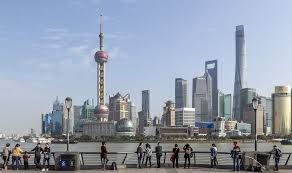Post-pandemic world needs better globalization, not less

Beijing: Even at a time when the coronavirus pandemic is sweeping the world, beef from New Zealand, red wine from Chile, and detergent from Germany remain just a click away to Chinese customers.
This offers a glimpse of how globalization has led to the creation of a highly integrated world web of interdependence and altered the way of living in many parts of this closely connected global community.
The ravaging pandemic, however, has jolted global supply chains and halted much of cross-border travels. It has also exposed once again some of globalization’s deep-seated deficiencies, and prompted many in academia, politics and the press to debate whether this marks the beginning of an end to this historic process.
It is not the first time that globalization has been questioned or assaulted in times of turbulence. Between the 2008 global financial crisis and this pandemic, sharp criticism against globalization was heard fueled by rising waves of trade protectionism and economic nationalism.
Nevertheless, being a natural process driven by the combined forces of technological breakthroughs, as well as the free flow of people and profit-thirsty capital, globalization has brought down trade and commerce barries, shrunk production costs, stimulated technological cooperation, integrated global markets and financial systems, created inestimable jobs and wealth, and raised living standards throughout the world over the centuries since the Age of Discovery.
These upsides of globalization are unmistakable, and will not be wiped out by a single global crisis. Arjun Appadurai, a U.S. globalization studies expert, argued in an opinion piece published by the Time magazine earlier this month that “globalization is here to stay,” and de-globalization efforts are no more than “wishful thinking.”
Thus the international community, instead of trying to turn inward and break away from each other, should come even closer and make globalization work better for everyone.
The first task should be for countries worldwide to make global production and supply chains more risk-resilient. This pandemic will not be the last one. Other unknown risks and new challenges are likely to emerge in the future.
While some Washington politicians are talking about reshoring the production of critical medical and technological supplies back to the United States, others like Shannon K. O’Neil, a senior fellow with the Council on Foreign Relations, argued that governments and boardrooms should add redundancies to the global manufacturing processes.
Information technologies have also been considered key to rendering future global supply chains more resilient. The World Economic Forum (WEF) suggested in an article published on its website last month that companies should stop recording data like ships’ cargo on paper, and start digitizing their supply chain processes so as to make sure critical information can always be available.
Whatever the proposals — reshoring, multi-sourcing or digitizing, China, with its comprehensive industrial advantages, will remain a critical part of any future global supply chains.
“I don’t think China’s role as a major source of manufacturing is going to be eliminated. They will continue to be so,” said Morris Cohen, a professor at The Wharton School, told Deutsche Welle last month.
Secondly, the international community should jointly enhance global economic governance and further boost global free trade.
In mid-April, the International Monetary Fund (IMF) projected that the global economy is on track to contract sharply by 3 percent in 2020 due to COVID-19, probably the worst recession since the Great Depression in the 1930s.
To forestall that nightmare scenario, governments should at the moment better coordinate their macro-economic policies so as to maintain market stability, prop up employment, conduct stimuli proportional to the ongoing pandemic, and restore global growth through such multilateral economic platforms as the Group of 20.
Also, they should give even stronger support to the rules-based multilateral trading system with the World Trade Organization (WTO) at the core. Right now, because of Washington’s intentional obstruction, the WTO’s Appellate Body, which has arbitrated international trade disputes over the past 25 years to ensure fairness, has been left inquorate.
The Financial Times, a British newspaper, argued in a recent editorial that the WTO is needed more than ever so that it can “underpin the open global economy we will all need on the other side of the pandemic.”
The U.S. administration should curb its protectionist impulses, and actively and fully back the existing global economic governance system.
The third front should be strengthening international cooperation so that countries worldwide can better respond to their shared non-conventional security challenges such as the COVID-19 pandemic.
Globalization is now far more than just economic integration. As the global village is highly interconnected, the human race needs to ramp up, not to dial down, trans-border cooperation in a bid to jointly tackle common challenges like deadly contagions, climate change, terrorism and cyber attacks, problems no country can solve single-handedly.
The most immediate mission should be stepping up global cooperation against the COVID-19 pandemic and bolster the backbone-role the World Health Organization has been playing in coordinating global endeavor to beat humanity’s common enemy.
The fourth task is to make globalization more inclusive for all. The pandemic has further revealed that globalization has not turned out to be a rising tide lifting all boats, and that it could further widen the global gap between the rich and the poor.
In a WEF research report earlier this month, which focuses on epidemics like H1N1 in 2009, MERS in 2012, and Zika in 2016, and traces out their distributional effects in the five years following each event, the Gini coefficient, a commonly-used index of inequality, has gone up by nearly 1.5 percent on average.
In the United States, the world’s largest economy, the outbreak recession has kicked millions of the most economically vulnerable Americans out of their jobs, while many are facing a dire choice between protecting their health or their jobs. Also, several racial minority groups account for a disproportionate number of the COVID-19 infections and deaths in the country largely due to lower living and working conditions as well as a lack of access to health care. In Wisconsin alone, a U.S. state with a 6-percent Black population, African Americans account for about half of its outbreak fatalities, according to a recent report by the Washington Post.
The pandemic offers decision-makers worldwide a chance to bridge those wealth and health gaps through refashioning policies like reordering tax codes, introducing universal health care coverage, and promoting common development through international cooperation in regions like Africa and the Middle East so as to make sure that the dividends of globalization can be shared by all global villagers.
Following the collapse of the U.S. subprime mortgage markets in 2007, shock waves swept financial sectors in all corners of the world, and the most serious financial tsunami since the Great Depression of the 1930s kicked in. Globalization then encountered a major setback. Yet despite all the second-guessing about it at that time, countries worldwide rose to the occasion and jointly steered the global economy through the uncharted waters and back onto the track of recovery.
“Our fractured world needs agile governance and smarter globalization,” Klaus Schwab, founder and chief executive of the WEF, once said.
The world will never be the same when this pandemic comes to an end, and neither will the process of globalization. The human race has every reason to repeat what they did in the aftermath of the 2008 financial crisis and work together to help this unstoppable trend take a turn for the better.





